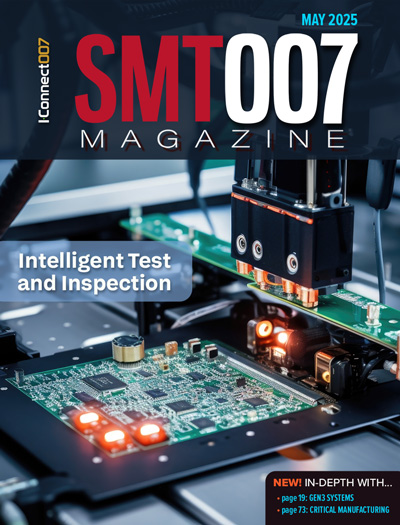-

- News
- Books
Featured Books
- smt007 Magazine
Latest Issues
Current Issue
What's Your Sweet Spot?
Are you in a niche that’s growing or shrinking? Is it time to reassess and refocus? We spotlight companies thriving by redefining or reinforcing their niche. What are their insights?

Moving Forward With Confidence
In this issue, we focus on sales and quoting, workforce training, new IPC leadership in the U.S. and Canada, the effects of tariffs, CFX standards, and much more—all designed to provide perspective as you move through the cloud bank of today's shifting economic market.

Intelligent Test and Inspection
Are you ready to explore the cutting-edge advancements shaping the electronics manufacturing industry? The May 2025 issue of SMT007 Magazine is packed with insights, innovations, and expert perspectives that you won’t want to miss.
- Articles
- Columns
- Links
- Media kit
||| MENU - smt007 Magazine
BTU to Discuss Furnaces for Precision Temperature / Atmosphere Applications at ASM’s Heat Treat 2015
September 21, 2015 | BTU International, Inc.Estimated reading time: 1 minute
BTU International, Inc., a leading supplier of advanced thermal processing equipment for the electronics manufacturing and alternative energy markets, today announced that it will exhibit at Heat Treat 2015, ASM’s Heat Treating Society Conference & Exhibition, scheduled to take place Oct. 21-22, 2015, at the Cobo Convention Center in Detroit, MI. BTU will highlight its controlled atmosphere furnaces in Booth #449.
These controlled atmosphere belt furnaces are available with temperature ranges up to 1150°C and with various process atmospheres including hydrogen and nitrogen. BTU designs and manufactures inline controlled atmosphere furnaces for a number of applications including: flux-free hydrogen wafer bump reflow, glass-to-metal sealing, direct bond copper, brazing, sintering and heat-treating.
BTU is the industry leader in atmosphere control for continuous furnaces. Whether dealing with high purity muffle applications or general purpose muffle-less applications, BTU has a unique set of capabilities, know-how and experience supporting precision temperature and atmosphere applications. Excellent atmosphere purity is achieved through the use of BTU’s patented gas barrier technology. In addition, BTU’s unique eductor technology can be used to enhance cooling or control process atmosphere. The end result is superior efficiency, superior performance and superior thermal uniformity.
BTU’s controlled atmosphere furnaces feature BTU’s proprietary WINCON™ control system. WINCON features a simplified user interface and incredibly powerful analytical capabilities.
About BTU International
BTU International, a wholly-owned subsidiary of Amtech Group (Nasdaq: ASYS), is a global supplier and technology leader of advanced thermal processing equipment and processes to the electronics manufacturing and alternative energy markets. BTU equipment is used in the production of printed circuit board assemblies and semiconductor packaging as well as in the manufacturing of solar cells and nuclear fuel. BTU has operations in North Billerica, Massachusetts, and Shanghai, China, with direct sales and service in the U.S.A., Asia and Europe.
Suggested Items
Trouble in Your Tank: Can You Drill the Perfect Hole?
07/07/2025 | Michael Carano -- Column: Trouble in Your TankIn the movie “Friday Night Lights,” the head football coach (played by Billy Bob Thornton) addresses his high school football team on a hot day in August in West Texas. He asks his players one question: “Can you be perfect?” That is an interesting question, in football and the printed circuit board fabrication world, where being perfect is somewhat elusive. When it comes to mechanical drilling and via formation, can you drill the perfect hole time after time?
The Evolution of Picosecond Laser Drilling
06/19/2025 | Marcy LaRont, PCB007 MagazineIs it hard to imagine a single laser pulse reduced not only from nanoseconds to picoseconds in its pulse duration, but even to femtoseconds? Well, buckle up because it seems we are there. In this interview, Dr. Stefan Rung, technical director of laser machines at Schmoll Maschinen GmbH, traces the technology trajectory of the laser drill from the CO2 laser to cutting-edge picosecond and hybrid laser drilling systems, highlighting the benefits and limitations of each method, and demonstrating how laser innovations are shaping the future of PCB fabrication.
Day 2: More Cutting-edge Insights at the EIPC Summer Conference
06/18/2025 | Pete Starkey, I-Connect007The European Institute for the PCB Community (EIPC) summer conference took place this year in Edinburgh, Scotland, June 3-4. This is the third of three articles on the conference. The other two cover Day 1’s sessions and the opening keynote speech. Below is a recap of the second day’s sessions.
Day 1: Cutting Edge Insights at the EIPC Summer Conference
06/17/2025 | Pete Starkey, I-Connect007The European Institute for the PCB Community (EIPC) Summer Conference took place this year in Edinburgh, Scotland, June 3-4. This is the second of three articles on the conference. The other two cover the keynote speeches and Day 2 of the technical conference. Below is a recap of the first day’s sessions.
Preventing Surface Prep Defects and Ensuring Reliability
06/10/2025 | Marcy LaRont, PCB007 MagazineIn printed circuit board (PCB) fabrication, surface preparation is a critical process that ensures strong adhesion, reliable plating, and long-term product performance. Without proper surface treatment, manufacturers may encounter defects such as delamination, poor solder mask adhesion, and plating failures. This article examines key surface preparation techniques, common defects resulting from improper processes, and real-world case studies that illustrate best practices.


